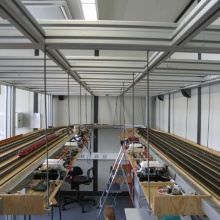Idea and conception
Our laboratory was developed with the aim of making possible the replication of various, often highly-complex, transportation systems with the direct integration of traffic and operation-oriented interfaces between different subsystems as a basis for universal and project-specific experiments in a comparatively simple manner. Therefore, a highly-modular setup with well-defined software interfaces was designated in order to facilitate data exchange between individual modules as well as adjacent sections of the transportation environment. Railway traffic is modelled through a previously-available railway modelling system.
Railway modelling system
The Institut für Eisenbahn- und Verkehrswesen of the University of Stuttgart integrated, in the time period 2004/05, an extensive railway modelling system into the previously-existing transportation research laboratory. This system is part of the “Virtuelles Eisenbahnnetz Baden-Württemberg” concept, which is slated to be used in the simulation of the circular line to be expected around the Stuttgart area upon the implementation of the Stuttgart 21 project, and will allow the traffic to be controlled within the planned control areas by operating personnel.
A certain section of the planned circular line will be realistically modelled on a 1:200 scale on the modelling system. The goal of the modelling system is to accurately represent the complex interdependencies in both operational and safety procedures and to depict their impacts on railway operations. It is planned for the modelling system to be operable primarily via software through all types of current interlocking systems, thereby applying both conventional as well as newly-developed operating procedures in the areas of teaching and research.
Description of the first stage of construction of the railway modelling system
The construction of the modelling system was segmented into several phases of construction. The first phase has been completed since 2005. This first section consisted of the assembly of an aluminum frame as well as the setup of the first of four levels of the modelling system. The first level was used for a representation of the planned state of the Stuttgart Main Station under the Stuttgart 21 project (Planfeststellungsabschnitt 1.1), as well as a temporary staging yard.
Target groups
The goal of the demonstrational installation was to realistically outline the complex interdependencies in the areas of railway traffic control and safety, as well as their influences on railway operation, for the following target groups:
- Students in the fields of engineering and computer science, as well as economists with the focus of training on the design of traffic systems at the IEV.
- Training for operating personnel in the field of railway operations as well as further education for both domestic and international university graduates.
- Interested visitors as an introduction to the field of railway operation, as well as for their recognition of the existing problems on the basis of practical experimentation.
Study project Marian
Through the teamwork of a group of engaged software engineering students, a control software was developed and implemented for the modelling system. This work aimed at targeting the highest possible level of modularity in order to allow the integration of further software modules as simply as possible. The final version of the software developed through the Marian project should serve as the control platform for real dispatching systems for track-guided traffic.
Contact

Feliks Polyak
Administration, laboratory, library




